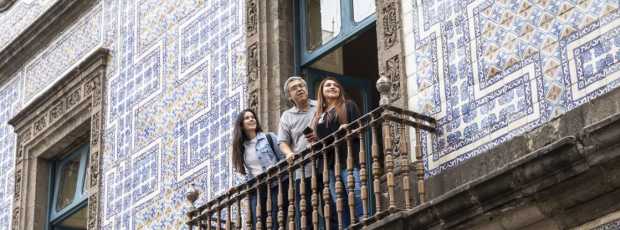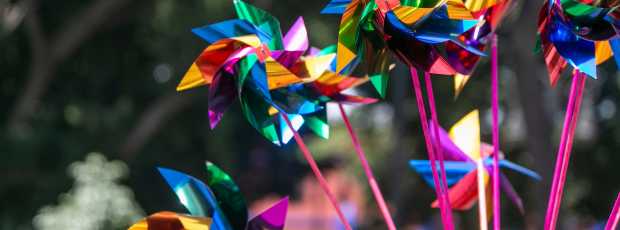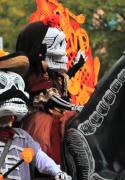Maxel delivered a walking tour that was worth every minute. He knew the history and the local context, but more importantly he made the city feel alive.Jalen, Mexico City, 2025
Discover Mexico City After Dark on a Private Night Tour
Bars, lights, and local stories - your way
Table Of Contents
- How Does Mexico City Come Alive After Dark?
- What Should You Eat in Mexico City at Night?
- Where Do Locals Drink After Dark?
- Where Can You Find Live Music and Culture?
- Which Neighborhoods Come Alive After Dark?
- What Are the Hidden Gems for Nightlife?
- What Are the Unique Local Night Traditions?
- Family-Friendly and Sober Night Options
- Overrated Picks and Better Alternatives
- Where Are the Best Night Views in Mexico City?
- Practical Tips for Navigating Mexico City After Dark
- Frequently Asked Questions
- Why Mexico City Nights Matter
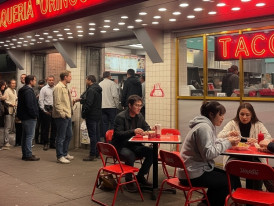
Roma Norte side street at night with taquería lights and people eating
Street vendors fire up their comals, mariachi musicians tune their guitars, and neighborhoods that felt sleepy suddenly pulse with energy.
I'm Sofía, born and raised in Mexico City, and I've spent the last decade guiding visitors through the neighborhoods I grew up in.
I host relaxed evening taco walks through Roma, and I'm constantly amazed by how many visitors miss the real pace of this ancient city after dark. They hit the rooftop bars on Paseo de la Reforma or queue for the most popular places in Centro Histórico, but the best things to do in Mexico City at night go far beyond the beaten path tourists stick to.
It's about finding that perfect mezcal bar where my neighbors drink, or learning which taco stand locals line up for at 10 PM (and why that line matters).
After thirty-plus years of late-night explorations and countless conversations with street vendors, cantina owners, and night shift workers, I know which corners of Mexico City truly come alive after dark.
Come explore the neighborhood treasures and Mexico City experiences that make nighttime in this remarkable city unforgettable.
How Does Mexico City Come Alive After Dark?
Mexico City doesn't follow the early dinner schedule that international travelers might expect.
Locals eat late, stroll even later, and the good food doesn't even start flowing until 8 PM. I carry three kinds of hot sauce because I know we'll hit at least four different stalls on any given Tuesday night.
This isn't a town where you grab dinner and head home. It's where you grab dinner, then wander to one of my favorite cantinas with good vibes, then maybe catch some live music, then definitely end with churros from the guy who parks his cart near Parque México every night until 2 AM.
The night heartbeat here moves between generations. Families with kids claim the plazas during evening light, young professionals pour into the best bars around 9 PM, and the late-night crowd takes over the underground clubs with house music until sunrise.
Every neighborhood has its own personality after dark, from the drag shows in Zona Rosa to quiet streets where dog parks become social hubs.
If you're exploring Mexico City for the first time, skip the ultimate guide mentality. The best experiences happen when you have just a few hours to explore with genuine curiosity.
Want to Experience Mexico City Firsthand?
Step into the neighborhood, scene, or story with someone who knows it inside out.

Street food vendor preparing tacos al pastor on a trompo with flames
What Should You Eat in Mexico City at Night?
The real food scene starts after 8 PM, when the day shift vendors pack up and the night specialists roll out their carts.
I've eaten at these stands my whole life, and I can tell you the difference between a tourist taco and the ones locals wait in line for at midnight.
Tacos El Huequito (Roma Sur)
The original al pastor spot that locals still choose over the flashy tourist versions. Pastor carved from vertical trompos, served on small tortillas with pineapple that's grilled for flavor. Open until very late (depending on the branch), perfect for post-bar sustenance.
Los Cocuyos (Centro Histórico)
The go-to spot for suadero, Mexico City's beloved slow-cooked beef that's crisped on the griddle and served with chopped cilantro and onion. Locals line up here past midnight for tacos that cost around 20 pesos each. It’s in the Centro Histórico (Bolívar 56) and is open 24 hours, great for nightly adventures. Cash only.
Quesadillas Doña Güe (Escandón)
A tiny blue cart that appears around 7 PM near the Patriotismo Metro. Doña Güe makes masa from scratch daily and stuffs quesadillas with flor de calabaza, mushrooms, and chicharrón prensado that locals swear by. Cash only, closes when she runs out.
Churros El Moro (Multiple locations, but hit the Eje Central spot)
The thick, crispy churros dusted with cinnamon and served with chocolate caliente so thick you could stand a spoon in it. The original location stays open late, and it's where taxi drivers, students, and night shift workers all converge around midnight.
Sopes Doña Mary (San Rafael)
Tucked on a corner near the Revolución Metro, Mary makes sopes with beans, lettuce, crema, and your choice of guisado from enormous clay pots. The cochinita pibil runs out fast, but her mole verde with chicken is worth the trip alone.
Tamales Oaxaqueños (Santa María la Ribera)
Look for the woman with the massive steamer pot near the Plaza Santa María around 8 PM. Her tamales oaxaqueños wrapped in banana leaves are nothing like the dense tourist versions. Light masa, complex mole, and she'll heat them perfectly on her comal.
For a complete breakdown of what to eat in Mexico City, these late-night staples represent just the beginning of the city's street food culture.
Hungry to Try Mexico City Yourself?
Taste and explore the flavors locals actually love.
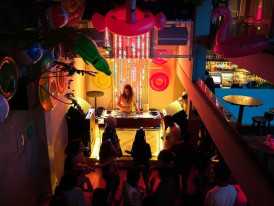
Interior of Bar Oriente
Where Do Locals Drink After Dark?
Forget the trendy spots with English menus and inflated prices. The bars and cantinas I'm sharing below are where my friends and I actually spend our Friday nights, from award-winning cocktail bars to century-old pulquerías where my grandfather used to drink.
Handshake Speakeasy (Colonia Cuauhtémoc)
Award-winning cocktail bar known for precise, inventive drinks and an intimate space. Regularly ranks among North America's top cocktail destinations. Reservations strongly recommended due to limited seats, especially on weekends.
Book ahead for serious cocktails in a small, polished room.
Mezcalería Los Amantes (Oaxaca)
A small bar in the Oaxaca neighborhood that stocks mezcals from producers across the area. The staff will walk you through tastings and explain the difference between espadín and tobalá without any pretension. No mezcal cocktails here, just pure agave spirit and conversation.
Las Duelistas (Centro Histórico)
A historic pulquería and cantina that's served locals since the early 1900s. The walls display boxing memorabilia and faded photographs, the pulque arrives fresh daily, and the crowd includes everyone from taxi drivers to office workers. Free botanas come with every drink order. Try the pulque curado with guava or stick with the traditional plain version.
A genuine neighborhood cantina where history and local tradition meet over pulque and beer.
Cantina La Coyoacana (Coyoacán)
A neighborhood cantina that's served the same families for three generations. Pulque made daily, cheap micheladas, and free botanas that include chicharrón and pickled vegetables. The clientele is mostly local workers getting off late shifts, and the jukebox still plays Vicente Fernández.
Pulquería Los Insurgentes (Roma Norte)
One of the few traditional pulquerías left in the city center, serving fresh pulque in clay cups with flavors like guava, celery, and traditional plain. The crowd skews young and artsy, but the drink recipe hasn't changed since the 1940s. Try the pulque with pineapple and chili. Your best bet for first-timers who want the experience without overpaying.
Bar Pata Negra (Condesa and Centro)
Lively tapas-and-drinks hangout with a broad beer list and solid cocktails. Good for groups and casual nights when you want music and movement without a full club. The Roma Norte location stays busy until late with a friendly neighborhood crowd.
Bar Oriente (Roma Norte)
A working-class bar that doubles as a social club for the neighborhood. Cheap beer, strong drinks, and a pool table that's seen better days. This is where you go to understand how locals unwind after work, where craft cocktails aren't the point.
Mexico City's drinking culture ranges from award-winning cocktail bars to historic cantinas serving pulque the way they did a century ago.
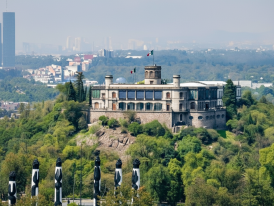
View of Chapultepec Castle
Where Can You Find Live Music and Culture?
Mexico City's cultural life doesn't shut down at sunset. Some of my favorite performances happen after dark, from lucha libre matches where entire families cheer together to intimate jazz clubs where I've discovered some of the country's best musicians.
Arena México Lucha Libre (Doctores)
Tuesday, Friday, and Sunday nights feature matches that locals attend. Sit in the general admission section with families who've been coming for decades, and you'll understand why lucha libre is theater, sport, and cultural expression rolled into one.
Cineteca Nacional (Xoco)
Late-night art film screenings, often featuring Mexican directors or restored classics. The venue itself is architecturally stunning, and the crowd includes film students, cultural workers, and anyone seeking an alternative to mainstream cinema. Check their cartelera for midnight showings.
Foro del Tejedor (Roma Norte)
An intimate live music venue in a restored colonial building that books indie bands, folk musicians, and experimental acts. Most shows start at 8 PM, and the acoustics are perfect for the singer-songwriter scene that thrives in this neighborhood.
Museo de la Ciudad de México (Centro Histórico)
The last Wednesday of the month feature extended hours with live music in the courtyard and access to rotating exhibitions of Mexican art. Much quieter than the big-name museums, and the building itself is a former palace worth visiting for the architecture alone.
Palacio de Bellas Artes (Centro Histórico)
While most associate this fine arts venue with daytime performances, evening hours show the building's stunning Art Nouveau façade illuminated against the night sky. Free exterior viewing, though guided tours cost extra and require advance booking in small group format.
Chapultepec Castle (Chapultepec)
The hilltop castle occasionally offers evening access during special cultural programming, providing panoramic views over the city lights. The surrounding park becomes one of my favorite places for sunset strolls before heading down to neighborhood cantinas.
Nicho Bears & Bar is one of the friendliest LGBTQ+ bars in the city, with karaoke nights that locals participate in.

Evening scene in Plaza Hidalgo, Coyoacán with families
Which Neighborhoods Come Alive After Dark?
When I guide night walks through the best neighborhoods in Mexico City, each one reveals a completely different side of the city's personality.
Roma Norte
Taquería El Tizoncito is the birthplace of tacos al pastor, still family-run and serving perfect late-night fuel. Mezcalería Alipús is a neighborhood institution for serious agave spirit lovers, with knowledgeable staff and zero tourist pandering. Parque España is where local families gather in evenings, kids play until late, and street musicians perform for donations.
Condesa
El Irlandés Pub isn't Irish, but it's genuinely local. A dive bar where Condesa residents drink. Parque México is perfect for evening strolls along tree-lined paths, with families walking dogs and couples on benches. The neighborhood's tree-canopy streets feel safe and walkable well past midnight.
Not Sure Where to Start in Mexico City?
A local can shape the day around what matters most to you.
Narvarte
Taquería El Vilsito is a mechanic’s shop by day and taquería by night that's been serving Narvarte locals since the 1960s. The pastor here is legendary, and the late-night crowd includes everyone from office workers to taxi drivers. It's worth the detour from Condesa or Roma if you want to see where neighborhood regulars actually eat.
Centro Histórico
Cantina La Ópera claims Pancho Villa shot a hole in their ceiling, and whether true or not, this cantina has served the same neighborhood for over a century. Azotea del Círculo is a rooftop that locals know but tourists don't, with direct cathedral views and prices that won't bankrupt you. Mercado de San Juan evening hours show a different side, with local families shopping for dinner ingredients.
Juárez/Zona Rosa
Nicho Bears & Bar is one of the friendliest LGBTQ+ bars in the city, with karaoke nights that locals participate in. Taquería Los Parados is a standing-room-only taco joint that's fed the neighborhood's night shift workers for decades. Mercado Juárez lets you browse local vendors selling everything from vintage vinyl to handmade crafts, with small food stalls serving regional specialties.
Coyoacán
Plaza Hidalgo weekend evenings bring folk musicians, art vendors, and families enjoying nieves from traditional ice cream carts. Casa Azul surroundings include streets around Frida Kahlo's museum worth exploring after tourist crowds thin out, with small cafés and bookshops staying open late. Mercado de Coyoacán evening hours feature traditional food stalls and local families doing their daily shopping, far from the daytime tourist rush.
Ever Wonder What Mexico City Feels Like Beyond the Sights?
Discover neighborhoods, flavors, and everyday life with a local
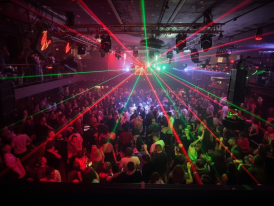
Patrick Miller Club
What Are the Hidden Gems for Nightlife?
These spots rarely appear in guidebooks, but they capture the real spirit of hidden gems in Mexico City after dark.
Salón Malafama (Roma Norte)
A vinyl bar behind a taquería where DJs spin everything from cumbia to electronic music. No sign outside, just look for the line of locals after 11 PM. The crowd includes artists, musicians, and neighborhood regulars who've been coming since it opened five years ago.
Parker & Lenox (Juárez)
New York jazz club vibes in a basement space that books local jazz musicians and occasional international acts. The cocktails are exceptional, but it's the late-night jam sessions on Thursdays that draw Mexico's best jazz players.
Café Paraíso (Roma Norte)
A high-energy late-night spot popular with locals, often very crowded. Best if you want a lively dance-party vibe. Arrive early on weekend nights to avoid long queues at the door.
Patrick Miller Club (Roma Norte)
Legendary weekend party with real dance battles on the floor, a friendly, no-judgment crowd, and classic beats all night. The space can get warm with all the dancing, so dress light and stay hydrated. Typically opens late on Friday and Saturday nights.
M.N. Roy (Roma Norte)
Named after the Indian revolutionary who lived in Mexico, this bar combines political history with excellent mezcal and a crowd of intellectuals, activists, and curious locals. Live music tends toward protest songs and nueva trova.
Don’t Just Visit Mexico City. Feel Part of It.
Locals share their city as they live it, so even a few hours can feel like you truly belong.
See how it works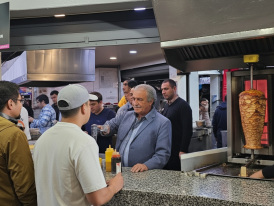
Taco stand with a long line of hungry people
What Are the Unique Local Night Traditions?
Mexico City's nighttime culture includes rituals and traditions you won't find anywhere else.
Mariachi at the Plazas
While Plaza Garibaldi remains the official mariachi headquarters, the real tradition happens in neighborhood plazas across Coyoacán, Xochimilco, and even small parks in Roma Norte. Mariachi bands roam from table to table at outdoor restaurants and cantinas, playing requests for tips. The etiquette is simple: tip before they play, not after, and expect to pay from 100 to 200 pesos per song depending on the venue.
Pulquería Culture
Traditional pulquerías serve fermented agave sap the way they have for centuries, often with hand-painted murals on the walls and free botanas with every round. The drink is slightly sour, milky, and low in alcohol. Locals treat pulquerías as social clubs where neighbors gather, play dominoes, and catch up on the week. Don't expect fancy glassware or craft cocktail presentations. This is working-class tradition at its most authentic.
Late-Night Street Food Rituals
The taco stand ritual follows a specific pattern. You order standing up, eat with your hands while standing at a metal counter, add salsa from communal bowls, and move on when you're done. There's no lingering, no table service, and no pretense. The best stands have long lines of locals after 10 PM, and the quality speaks for itself. Bring cash, know your order, and don't block the flow.
Mexico City's night traditions revolve around mariachi music, pulque culture, and the standing-room-only ritual of late-night street tacos.
What If Your Next City Day Didn’t Come From a Guidebook?
Instead of following a script, we connect you with someone who lives there and knows the places worth your time.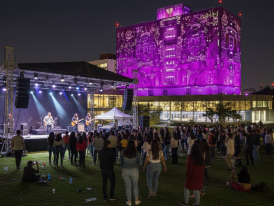
Centro Cultural Universitario outdoor concert
Family-Friendly and Sober Night Options
Not every night out requires alcohol or late hours. Mexico City offers plenty of evening activities perfect for families and those seeking non-drinking experiences.
Evening Plazas and Parks
Plaza Hidalgo in Coyoacán fills with families every weekend evening. Kids run between fountains, street performers entertain crowds, and vendors sell traditional nieves (Mexican-style ice cream) and aguas frescas made with fresh fruit. Parque México and Parque España in Condesa remain lively until 10 PM with families walking dogs and children playing in safe, well-lit spaces.
Night Markets
Bazaar Sábado in San Ángel runs until 7 PM on Saturdays, featuring artisan crafts, live music, and family-friendly food stalls. Mercado de Coyoacán stays open late with vendors selling traditional snacks like esquites (street corn in a cup), fresh fruit with chili and lime, and tamales.
Late Bakeries and Sweet Shops
Panadería Rosetta in Roma Norte stays open until 10 PM serving conchas, orejas, and other Mexican pastries alongside excellent coffee. Nevería Roxy in Coyoacán serves traditional ice cream flavors like tequila, corn, and avocado until late evening. These spots attract families and provide a sweet end to evening strolls without the bar scene.
Cultural Centers
Centro Cultural Universitario hosts free outdoor concerts and theater performances many evenings, with family-friendly programming that showcases Mexican music and dance. The campus itself is beautifully lit at night and safe for walking.
Families and non-drinkers can enjoy evening plazas, night markets, traditional bakeries, and free cultural performances across the city.
Mexico City Is More Than Its Checklists
Step into tucked-away places and everyday stories you won’t find on maps.
Overrated Picks and Better Alternatives
Skip the tourist traps and try these local favorites instead.
Overrated: Polanco rooftop bars with bottle service
Better Alternative: Azotea del Círculo in Centro Histórico for cathedral views without inflated prices, or Parque Lincoln for clock tower/gallery, aviary, ponds, and open-air theater.
Overrated: Plaza Garibaldi mariachi experience
Better Alternative: Smaller venues in Coyoacán or organic mariachi performances at neighborhood cantinas where musicians play for locals, not tourist groups.
Overrated: Touristy al pastor stands in Centro Histórico
Better Alternative: Tacos El Huequito in Roma Sur or Los Cocuyos for suadero, where locals actually line up at midnight.
Overrated: Upscale mezcalerías in Polanco
Better Alternative: Pulquería Los Insurgentes or Mezcalería Los Amantes in Oaxaca for better prices and genuine neighborhood atmosphere.
The best experiences usually cost less, draw local crowds, and avoid English-language signs.

Mexico City skyline at dusk from an elevated viewpoint
Where Are the Best Night Views in Mexico City?
I've climbed every viewpoint in this city, from famous observation decks to hilltop parks locals use for evening jogs. These spots offer perspectives you simply can't get during the day, when the entire valley lights up like a constellation stretching to the mountains.
Cerro de la Estrella (Iztapalapa)
A hill park that offers sweeping views of the whole city's lights, especially beautiful during clear winter nights. Take a ride-hailing service up and walk the paths. Locals come here for evening exercise and quiet contemplation.
Parque Lincoln (Polanco)
Much quieter than Parque México but equally beautiful for evening strolls, with well-lit paths and an observation deck that overlooks the Polanco skyline. Families use this as their neighborhood dog park after work hours.
Torre Latinoamericana Observation Deck (Centro Histórico)
Skip the expensive restaurant and head straight to the observation deck for panoramic city views. Best visited around sunset when the historic center's colonial buildings glow golden, then stay to watch the city lights come alive.
Takeaway: From hilltop parks to observation decks, Mexico City's elevated viewpoints offer stunning perspectives on the sprawling metropolis below.

View of the Torre Latinoamericana
Practical Tips for Navigating Mexico City After Dark
The Metro typically closes around midnight on weeknights. After that, use official taxis or ride-hailing apps, which are generally safe and reliable in busy areas.
Keep some cash handy since many of the best local spots don't accept cards, and street food vendors definitely don't.
Mexico City is generally safe in the neighborhoods I've mentioned, but use common street smarts: stay on well-lit streets, don't flash expensive electronics, and trust your instincts.
The weather is pleasant year-round for evening activities, though summer rains from June through September might send you seeking roofed spaces like pulquerías or indoor venues.
Travel insurance is worth having for any international trip, but Mexico City's healthcare system is solid if you need it.
Most restaurants don't take reservations, and many of the best spots work on a first-come basis. That's part of the charm. You never know exactly what you'll find on any given night.
If you're considering day trips from Mexico City during your visit, plan to return by evening so you don't miss the city's unmatched nighttime energy.
Wish You Could Just Ask a Local?
Book a quick video call and get insider answers to your trip questions.
Frequently Asked Questions
1) Is Mexico City safe at night?
Mexico City is generally safe in busy areas and established neighborhoods like Roma Norte, Condesa, and parts of Centro Histórico. Stay on well-lit streets, use ride-hailing for late-night transport, and avoid displaying valuables. The areas I recommend see regular foot traffic and local police presence.
2) What time do people eat dinner in Mexico City?
Locals typically eat dinner from 8 PM to 10 PM, much later than most international travelers expect. Many restaurants don't get busy until 9 PM, and street food vendors hit their stride around the same time.
3) Where can I hear mariachi music?
Plaza Garibaldi remains the traditional mariachi square, but for a more local experience, try smaller venues in Coyoacán or listen for street musicians in neighborhood plazas during weekend evenings. Always tip musicians before requesting songs.
4) What's the best neighborhood for nightlife?
Each neighborhood offers different vibes: Roma Norte for hip bars and excellent street food, Zona Rosa for LGBTQ+ friendly venues, Centro Histórico for historic cantinas and rooftop views, and Condesa for relaxed evening strolls and neighborhood bars.
5) Are there vegetarian options for late-night eating?
Absolutely. Quesadillas with flor de calabaza (squash blossoms), mushrooms, or cheese are available at most taco stands. Many vendors also serve esquites (street corn) and fresh fruit with chili and lime.
6) How much should I budget for a night out?
Street food costs from 15 to 30 pesos per taco, local cantinas charge from 50 to 80 pesos for beer, and mezcal bars range from 80 to 150 pesos per drink. A full night of local-style eating and drinking might cost from 500 to 800 pesos total.
7) What's the dress code for bars and restaurants?
Mexico City nightlife is generally casual. Clean jeans and a nice shirt work almost everywhere. Some upscale venues might prefer business casual, but the neighborhood spots I recommend are relaxed about dress codes.
8) Can I walk between neighborhoods at night?
Within neighborhoods like Roma Norte or Condesa, walking is perfectly fine on main streets. For longer distances or between different areas, use ride-hailing services, especially after midnight when foot traffic thins out.
9) What's the legal drinking age?
The legal drinking age is 18, and establishments typically check ID. International visitors should carry their passport or a certified copy when planning to visit bars or clubs.
10) Are there any areas I should avoid?
While Mexico City is generally safe, some peripheral areas see less foot traffic after dark. Stick to the neighborhoods I've mentioned, and if you're unsure about an area, ask locals or your accommodation for current advice.
11) How do I get to Plaza Garibaldi safely?
Take the Metro to Garibaldi station or use a ride-hailing service. The plaza itself has police presence and stays busy with tourists and locals, but be aware of your surroundings and keep valuables secure. The surrounding area becomes quieter late at night.
12) What's pulque and where should I try it?
Pulque is a traditional fermented agave drink with a slightly sour, yeasty taste. Try it at Pulquería Los Insurgentes for a tourist-friendly introduction, or venture to neighborhood pulquerías for the full traditional experience.
13) Are there late-night cultural activities?
Several venues offer evening cultural programming: Cineteca Nacional for art films, Foro del Tejedor for live music, and various galleries in Roma Norte host evening openings and artist talks.
14) What's the best way to find current events and shows?
Check local publications like Chilango magazine online, venue Facebook pages, or ask at your accommodation. Many cultural spaces post their programming on Instagram and local event apps.
15) How late do restaurants stay open?
Most restaurants close by 11 PM on weeknights and midnight on weekends, but street food vendors often operate until 2 AM or later. Taquerías and late-night spots keep different hours than sit-down restaurants.
16) Can I use credit cards at night markets and street vendors?
Cash is king for street food, local cantinas, and traditional markets. Bring small bills since vendors often can't make change for large denominations. Some upscale bars and restaurants accept cards.

Night view of Palacio de Bellas Artes illuminated against a dark sky
Why Mexico City Nights Matter
The thing about Mexico City at night is that it shows layers you'd never see during daylight hours. Those busy streets that feel chaotic during the day become intimate networks of neighbors, night shift workers, and adventurous eaters all following the same pace.
I've lived here my entire life, and I still find new corners, new taco stands, and new favorite places in residential neighborhoods that come alive only after the sun sets.
This isn't about checking items off a tourist list or hunting Instagram moments. It's about understanding how locals live and have fun in this ancient city that never sleeps.
Whether you're drawn to the mariachi traditions at Plaza Garibaldi, curious about Diego Rivera's influence on local culture, or interested in the underground electronic music scene, the best Mexican experiences happen when you slow down, follow your nose toward good smells, and let the city's natural nighttime pace guide you from one spot to the next.
More Mexico City For You
Ready to Plan Your Perfect Day in Mexico City?
Start your experienceWhat If Exploring a Mexico City Felt More Personal?
City Unscripted pairs you with someone who lives there, so you can see iconic sights and hidden corners in a way that feels like yours.
See how it worksWish You Had a Local Friend in Mexico City?
One who knows the city inside out and could plan a private day just for you? Our local hosts do exactly that: no scripts, no tourist traps, just the side of the city most people miss.


